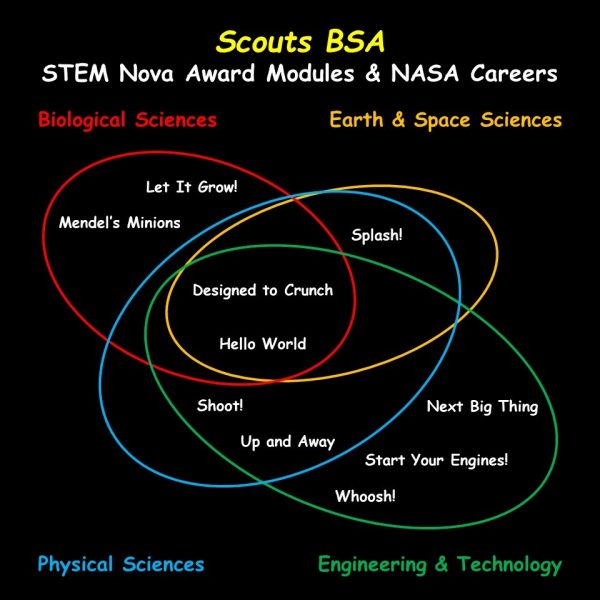Scouts BSA
![Assistant Scoutmaster Drew Morgan aboard the International Space Station. [iss061e064517, cropped]](https://www1.grc.nasa.gov/wp-content/uploads/Drew-Morgan-600x200.jpg)
NASA stands for the National Aeronautics and Space Administration, where aeronautics is the science of flight. Therefore, the Aviation and Space Exploration merit badges are two obvious choices to prepare for a NASA career. However, there are many trails that can be followed through Scouting activities to NASA, for example in the biological sciences, Earth and space sciences, physical sciences, and various technologies.
As a starting point, consider the Exploration merit badge which was created with the help of former astronaut Scott Parazynski, an Outstanding Eagle Scout and the only person to have both flown in space and summited Mount Everest. There are several other merit badges that can provide a foundation for discovery regardless of the path followed. These merit badges especially have to do with uncovering and contributing to scientific knowledge:
Data collection: Photography, Moviemaking
Data analysis: Digital Technology, Programming (perhaps first learned via Game Design)
Sharing findings: Communication, Digital Technology, Graphic Arts, Moviemaking, Animation
Biological Sciences
Those interested in exploring how life adapts to a space environment, how to maintain human health and performance, or how to find extraterrestrial life may want to consider these merit badges:
General: Environmental Science, Nature
Plants: Forestry, Gardening, Plant Science
Animals: Animal Science, Bird Study, Fish & Wildlife Management (perhaps inspired by Fishing or Fly Fishing), Insect Study, Mammal Study, Reptile and Amphibian Study, Veterinary Medicine (perhaps inspired by Pets or Horsemanship)
Humans: Dentistry, First Aid, Health Care Professions (replacing Medicine), Personal Fitness (perhaps inspired by Athletics, Sports, etc.), Public Health
Regarding humans, a significant fraction of NASA’s career astronauts earned a doctorate in medicine where an example is Eagle Scout Kjell Lindgren.
Earth and Space Sciences
Those interested in exploring the Earth, sun, our solar system, or the universe may want to earn these merit badges:
General: Astronomy, Geology, Oceanography, Weather
Earth: Energy, Environmental Science, Soil and Water Conservation, Sustainability
While the Geology, Oceanography, and Weather merit badges apply to the Earth, other planets – not to mention moons – can have oceans, experience weather, etc.
Physical Sciences
NASA uses the apparent weightlessness (or microgravity) in spacecraft to discover how and why things behave as they do in the physical sciences. Examples of such studies include biomaterials, ceramics, flames, fluids, metals, and plasma. Researchers working in this area often have engineering degrees where merit badges that could prepare Scouts for this kind of work include the following:
General: Chemistry, Drafting, Engineering, Inventing, Nuclear Science
Engineering & Technology
While scientists explore how and why in their search for understanding, NASA engineers use science and math to address mission needs, solve problems, and develop new technologies that can enable future exploration. NASA’s mission needs include both aviation and human spaceflight, plus the hardware and software needed to conduct scientific exploration. As a few examples, the latter can include experimental hardware on the space station, satellites orbiting the earth, and rovers on other planets.
There are many different engineering disciplines where some which can lead to a NASA career include aeronautical, aerospace, astronautical, biomedical, ceramic, chemical, civil, computer, electrical, electronics, industrial, materials, mechanical, metallurgical, nuclear, optical, structural, and welding engineering. As a result, there are many different merit badges that can aid Scouts in their journeys to a NASA career, where this is a suggested, but not necessarily complete, list:
Engineering: Aviation, Chemistry, Composite Materials, Digital Technology, Drafting, Electricity, Electronics, Engineering (perhaps inspired by Pioneering), Inventing, Nuclear Science, Programming, Robotics, Space Exploration, Welding
Technical Skills: Automotive Maintenance, Drafting, Electricity, Electronics, Farm Mechanics, Home Repairs, Metalwork, Model Design and Building, Plumbing, Welding, Woodwork
While engineers design and invent, technicians prepare schematics, fabricate components, assemble hardware, conduct tests, and operate research facilities. As with engineers, a wide variety of technicians work for NASA. There are considerable overlaps in the skills needed by technicians, engineers, and those investigating the physical sciences.
While merit badges like Farm Mechanics and Woodwork may not seem to correspond to NASA’s missions, basic skills that one might gain by working on a tractor or building a bookshelf can be applicable to work on the leading edge of technology. Understanding technical drawings, carefully following procedures, and safely working with tools are a few examples.
While the discussion above is focused on merit badges, the various STEM Nova Award modules can also help prepare Scouts for NASA careers as can be seen in the graphic below.

Beyond Scouting, youth considering a next step toward NASA careers may want to participate in one or more of the agency’s internship programs.
NASA Links:
• Astrobiology
• Earth
• Flight
• Human Health & Performance
• Humans in Space
• NASA for Students in Grades 5-8
• NASA for Students in Grades 9-12
• Physical Sciences
• Science
• Solar System
• Space Biology
• Space Tech
• Sun
• Universe
